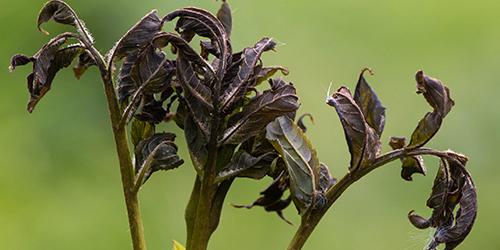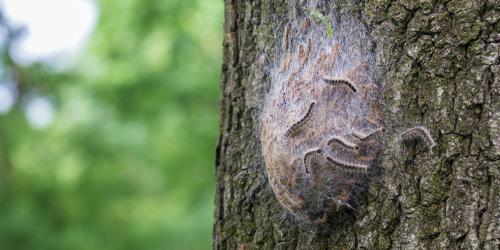Tree pests and diseases
Pests and diseases have been accidentally introduced to the UK from abroad. They are sweeping through the countryside. At least 20 are attacking our native trees, with six at epidemic levels.
Many more are at risk from international trade and a warmer, wetter climate. Two of the most dangerous threats to our trees are:
Ash Dieback (Hymenoscyphus fraxineus)

Ash Dieback will kill around 80% of Ash trees across the UK. This will likely have devastating effects. It will change the landscape and threaten many species that rely on Ash.
Ash Dieback can affect Ash trees of all ages. Younger trees succumb to the disease quicker. The leaves will start to develop dark patches during the summer. These leaves will wilt and turn from brown to black. The bark of live shoots and twigs turn darker, often with a purple tinge. You may often see dead, blackened leaves among the live ones.
The disease will cause diamond shaped lesions. Lesions are areas of discoloured, sunken and dead bark. These lesions can eventually wrap around and kill the affected branch, stem, or trunk. Often, trees will respond by growing new shoots and leaves beneath the lesion.
Care must be taken when identifying the disease. Other diseases may cause similar symptoms.
Online guides to help identify the disease have been produced by:
- The Forestry Commission
- Woodland Trust
- Arboricultural Association
- Observatree Field Identification guide
- Tree Council Ash Dieback in larger trees ID guide
- How to identify Ash Dieback in the field
What happens to the tree?
The fungus overwinters in leaf litter, especially on Ash leaf stalks. It produces small white fruiting bodies from July to October. They release spores into the air.
These spores can blow tens of miles away. They land on leaves, stick to and then penetrate into the leaf and beyond. The fungus then grows inside the tree. It blocks its water transport systems. The tree can fight back. But, infections will eventually kill it.
What to do if you spot Ash Dieback
If you think you've found signs of Ash Dieback, report it to Forest Research. Gardeners and managers of parks with Ash trees can help stop the spread of Ash Dieback. They should collect, then burn, bury, or deep compost the fallen Ash leaves. This disrupts the fungus's lifecycle.
The Oak Processionary Moth

The Oak Processionary Moth (OPM) gets its name from the behaviour of the caterpillars' movements. The caterpillars of these moths feed on oak leaves. This causes severe loss of photosynthetic material.
It can reduce trees' longevity and make them more vulnerable to diseases. This pest poses a threat to human, livestock, and pet health.
OPM has been spreading rapidly. It is now in much of greater London and some surrounding areas, including Harrow. All sightings should be reported to the Forestry Commission.
The Forestry Commission does not fund control; this is up to the tree owner and not a legal need.
The caterpillars' hairs can cause allergic reactions as they contain toxins. They can cause itching skin lesions. They can also cause sore throats, breathing difficulties, or eye problems.
This can happen if people touch the caterpillars or nests, or if the hairs are blown into contact by the wind.
- Try to avoid contact with the nests and caterpillars. Keep pets and livestock at a safe distance.
- The nest may persist for several years. Please treat these with the same caution as a live nest.
- You should see a doctor immediately if you come into contact with OPM.
- If pets or livestock come into contact, speak to a vet as soon as possible.
Preventing the spread of OPM
Taking action will depend on which of the three OPM management zones your affected trees are in. Guidance on the zones can be found in The Oak Tree Owners' OPM manual.
These are subject to change as they are reviewed each year.
Report a sighting of OPM
You can report a sighting of OPM online by:
-
Completing the Forestry Research's tree alert form.
If you are unable to use the form, you can:
- email: opm@forestrycommission.gov.uk
- call: 0300 067 4442
Please provide as much detail as possible. Include an accurate location where possible.
How OPM is treated
Different treatments are recommended. This is depending on the moth's life-cycle stage. Treatments include: spraying, nest removal and traps. During April and June, while the caterpillars are young and feeding in the canopy, the entire canopy can be sprayed. They are sprayed with an approved, eco-friendly pesticide. The tree is then re-sprayed 7-10 days later.
The most effective time to remove OPM is between June and July. This is when the caterpillars have settled into their nests. They are are less likely to be feeding in the foliage.
Full body PPE is worn and nests are collected by hand, removed from site and disposed of. Nests observed outside of April and June are likely to be old or abandoned but should still be removed.
Between April and July is the greatest risk period and when there are many caterpillars. Nests found during this time should not be approached.
Pheromone traps are used between July and September. This is the final life-cycle stage, to trap adult male moths. This controls the spread and also provides insights into moth numbers.
For more information about OPM see: